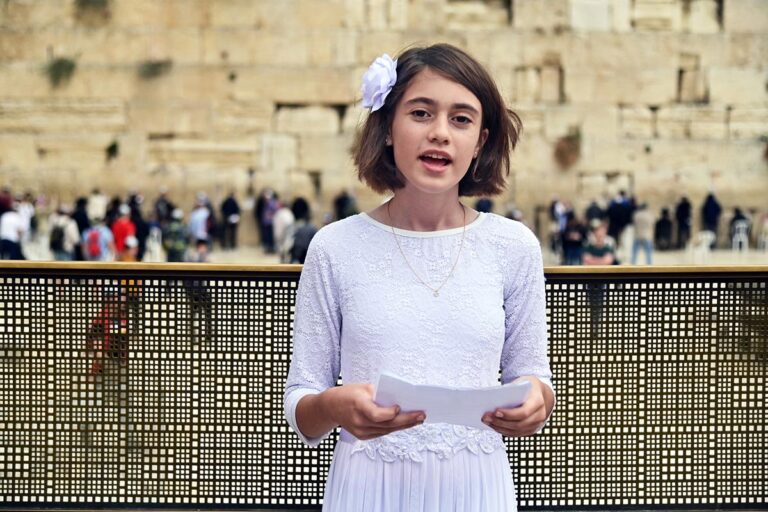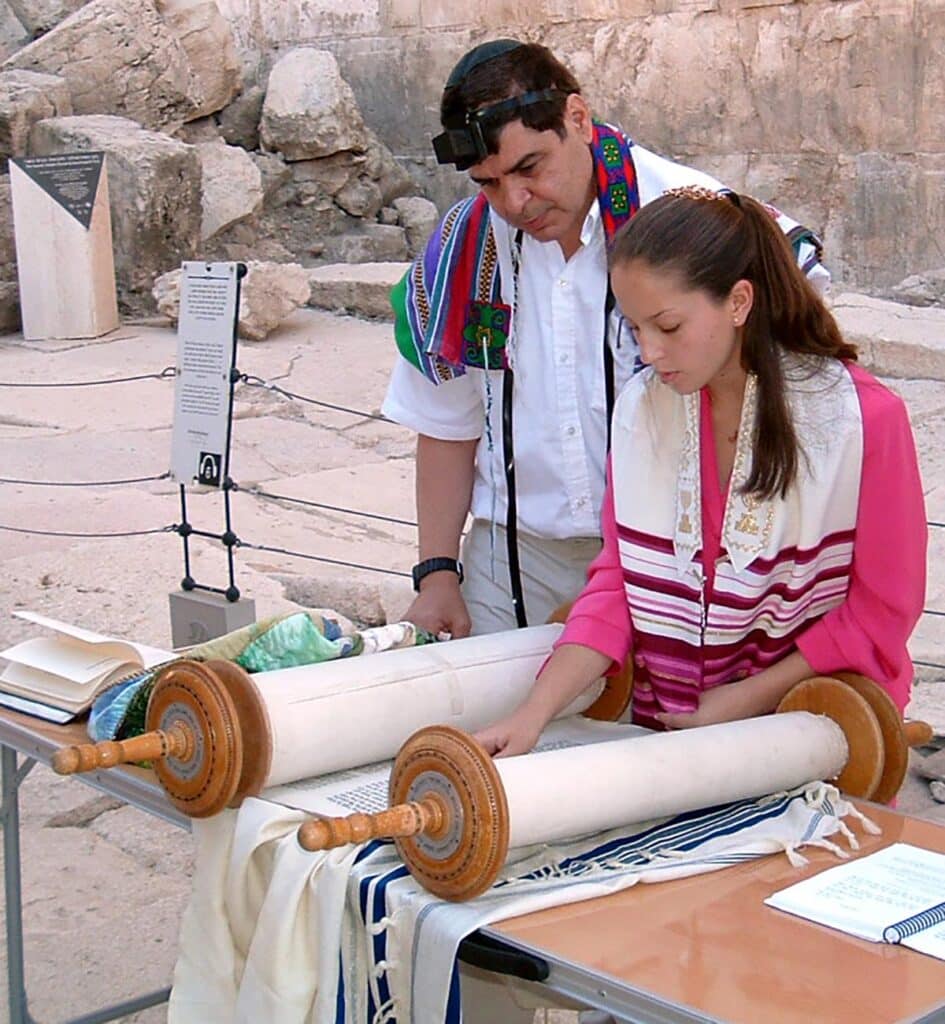
If you’re Jewish or had Jewish classmates, you probably remember bar and bat mitzvah season — the time between seventh and eighth grade when each weekend is booked by a classmate’s ceremony and party.
You might remember parties with the “Cha Cha Slide” booming and preteen girls running around the dance floor in their socks — because who would ever want to wear heels for the entire night?
This tradition was recently brought to the big screen with Adam Sandler’s “You Are So Not Invited to My Bat Mitzvah,” which follows 13-year-old Stacy Friedman as she learns what it means to come of age and own up to her mistakes.
At the core of the story is the essence of becoming a bat mitzvah: becoming an adult in the eyes of the Jewish people and taking responsibility for one’s actions.
However, this was not always the case. The bar and bat mitzvah as we know it today began in the 12th century and has evolved significantly through the centuries. Let’s take a deeper dive into the history and significance of the bat mitzvah.
What does it mean to be a bar or bat mitzvah?

First, what is a bar or bat mitzvah in the first place? In Hebrew, the term translates to “son” or “daughter” of the commandment. In other words, the young person is now obligated to perform mitzvot (commandments) and follow Jewish laws.
All Jews become bar or bat mitzvah when they turn 13 (or 12 for girls in Orthodox communities), regardless of whether they have a ceremony marking this milestone. The ceremony is a commemoration of this automatic religious status change.
Reaching the age of bar or bat mitzvah signifies that the child must start taking responsibility for their actions as part of the Jewish community. When one is a bar mitzvah, they can be counted in a minyan (the quorum of 10 adults needed to worship), receive an aliyah and chant Torah from the bimah, and lead some or all of the congregational service.
However, individuals who did not celebrate their bar or bat mitzvah at the traditional age — including converts to Judaism and women who turned 12 before the widespread adoption of bat mitzvah ceremonies — have the opportunity to participate in these ceremonies at any point in their lives.
In some communities, even for those who celebrated a bar or bat mitzvah, there is a second opportunity to become bar or bat mitzvah: On one’s 83rd birthday. The Torah says the average lifespan is 70 years, so some consider an 83-year-old to have turned 13 in their second lifetime.
While the party for these second-time b’nai mitzvot is usually less elaborate, the service traditionally remains the same with an aliyah, chanting Torah and a d’var Torah.
For those seeking to become bar or bat mitzvah — for the first or second time — synagogues offer classes for adults, just as they do for preteens. These classes delve into Jewish values, liturgy, Torah and Hebrew.
The history of the bar mitzvah
The concept of a Jewish boy becoming an adult at the age of 13 is rooted in early rabbinic texts. However, the bar mitzvah ceremony as we know it today did not take its current form until the early Middle Ages.
Prior to this period, the concept of “adulthood” was less defined. Families would decide when their son was ready to observe the mitzvot, rather than adhering to a specific age or ceremony.
This meant that a boy could be called for an aliyah or begin wearing tefillin whenever deemed mature enough by his family, with no additional religious responsibilities assigned. It wasn’t until the late Middle Ages that the transition to Jewish adulthood began to be marked with a ceremony or public acknowledgment.
Mordecai ben Hillel, a 14th-century scholar, was the first to use the term “bar mitzvah” to refer to someone over the age of 13. Prior to this, terms such as “gadol” (adult) or “bar onshin” (one who is accountable for their own actions) were used.
By the 16th century, the customs had evolved to exclude minors from receiving an aliyah and wearing tefillin. Upon turning 13, boys would chant from the Torah and lead prayers, signifying their entry into Jewish adulthood.
Over time, additional elements have been incorporated into the bar mitzvah celebration, including community service projects, communal luncheons, and elaborate parties.
Despite these additions, the core practices of the bar mitzvah have remained constant, with reading from the Torah and delivering a d’var Torah continuing to be central components of the ceremony.
What does a bar and bat mitzvah ceremony look like today?
Before the ceremony, most synagogues require people to enroll in Hebrew school, attend a certain number of Shabbat services, and complete a mitzvah project, a community service initiative. Additionally, the bar or bat mitzvah candidate must learn specific sections of the service they will lead.
During the ceremony, the bar or bat mitzvah is called to the bimah for an aliyah and chants that week’s Torah portion. Some also recite a haftarah, a passage from the book of Nevi’im (Prophets), either in addition to a Torah portion or instead of one.
The tradition of accompanying a bar mitzvah with a celebratory event dates back to the 13th century. While some opt for intimate gatherings with family or a communal kiddush lunch at the synagogue, others host elaborate parties in honor of their child’s transition into Jewish adulthood.
A unique way some families commemorate this milestone is by taking their child on a special trip, often to a place with familial or Jewish significance.
The emergence of the bat mitzvah
The tradition of celebrating a Jewish young woman’s coming of age can be traced back to ancient Rome. Historical records from the Great Synagogue in Rome, over 2,300 years ago, show that teen girls were called to the bimah to mark their entry into adulthood.
By the 1800s in Eastern Europe, a girl’s bat mitzvah was observed with a dedicated service but without an accompanying party. Around the same time, in Prussia, confirmation ceremonies celebrating young women became popular, and similar ceremonies started emerging in the Hungarian and Ottoman empires.
The first known bat mitzvah in U.S. history took place just over a century ago. On March 18, 1922, 13-year-old Judith Kaplan became the first girl to celebrate a bat mitzvah in the U.S.
Kaplan, the daughter of Rabbi Mordecai Kaplan, the founder of Reconstructionist Judaism, read from the Torah and recited blessings. Rabbi Kaplan later oversaw the second, third and fourth bat mitzvah ceremonies in the U.S. at his New York City synagogue — for his three younger daughters.
In the decade following Judith Kaplan’s ceremony, more members of her father’s synagogue began having bat mitzvahs; other rabbis also advocated for bat mitzvahs for their own daughters. Jewish summer camps, where teens led their own services and challenged community norms, also became venues for girls to celebrate bat mitzvahs.
By the end of the 1950s, half of Conservative synagogues and a third of Reform temples held bat mitzvahs, according to NPR. This trend amplified in the 1960s when second-wave feminists began pushing for women to read Torah and to be counted in a minyan.
It wasn’t until the 1970s, however, that bat mitzvah ceremonies as we know them today became widespread.
Today, in Reform, Conservative and Reconstructionist synagogues, there isn’t any distinction between a girl’s bat mitzvah and a boy’s bar mitzvah. In these movements, young women are allowed to receive an aliyah, lead services, offer divrei Torah, and read from the Torah publicly.
In many Orthodox communities, the roles of women have evolved in recent decades. Although most Orthodox synagogues still reserve aliyot for men, some Modern Orthodox communities now hold women’s minyanim, where women lead full services exclusively for female attendees.
Some Orthodox communities mark a girl’s bat mitzvah by inviting her to give a d’var Torah, read from the Book of Esther or the Book of Psalms, or lead the community in prayers.


